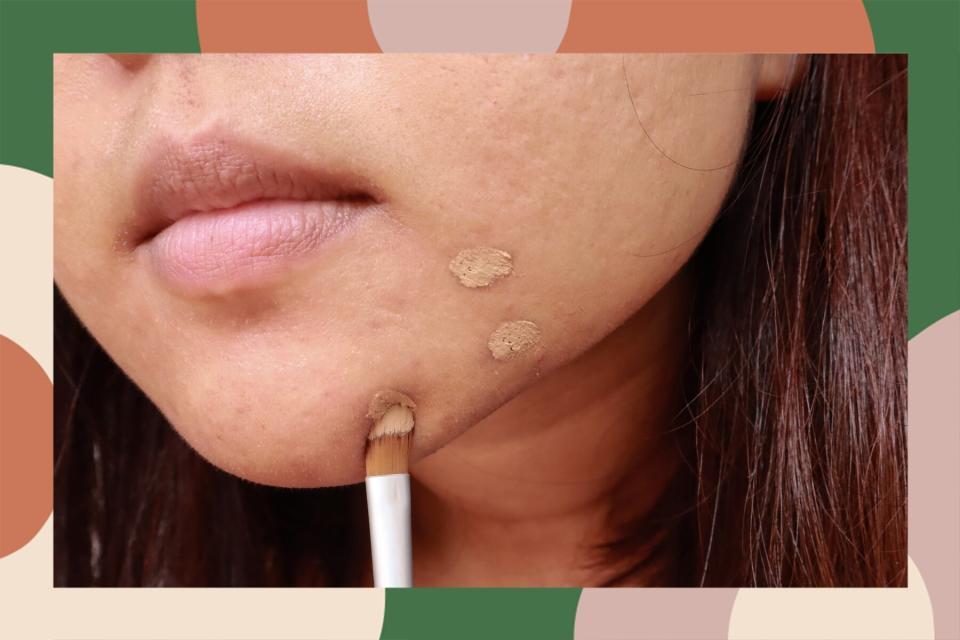How to Cover and Conceal Every Type of Pimple, According to Makeup Artists

Getty Images
Disclaimer: Flawless, poreless skin doesn't exist, so let's go ahead and throw out that idea. Acne, breakouts, and dark spots are totally normal, so there's no need to feel ashamed if your skin has added texture or discoloration, and you shouldn't feel pressured to conceal your natural skin if you don't want to. However, we'd be lying if we said we never let a pimple get us down. Sometimes, a little concealer is the key to achieving an extra boost of confidence or to perfecting a dramatic makeup look—and there's nothing wrong with either. No matter the reason, though, covering up acne with makeup can sometimes feel like trying to cover crayon with a marker, and it can be an incredibly frustrating pursuit.
So, we asked makeup artists for advice on how to cover a pimple and other forms of acne. From the occasional pimple and blackheads to cystic acne and acne scars, keep reading to learn how to cover every type of spot and blemish.
How to prep skin to cover a pimple:
The number one tip you need to follow to expertly cover pimples is to keep your skin moisturized. "Acne and pimples tend to get really dry and patchy under makeup, so you want to make sure to moisturize well, even if you have oily skin," celebrity makeup artist Cara Lovello says.
"Applying concealer over dry skin is a big no-no," adds celebrity makeup artist Renée Loiz. "It will accentuate acne or pimples." So, she recommends using the BeautyStat Cosmetics Universal Pro-Bio Moisture Boost Cream, which is formulated with hyaluronic acid, to prep the skin for makeup. Keeping the skin moisturized is also important if you want to cover up a pimple scab, as well.
hellogiggles - 50 Available at Amazon
If you have oily skin and are worried about making your skin look even shinier with moisturizer, Lovello recommends following your moisturizer with a mattifying primer to absorb excess oil and create a smooth canvas for your makeup.
hellogiggles - 8 Available at Amazon
How to cover small pimples or blemishes:
Loiz says that a common mistake people make when trying to conceal blemishes is not using a color corrector. To cancel out red pimples, she recommends using a green color corrector and applying it with a small concealer brush. "Apply directly on top of the blemish, starting out with a little and adding more as needed. Then, set it in place by patting it in with a clean finger," she suggests. "To finish, apply concealer on top of the color corrected spots and set it with a loose translucent powder."
hellogiggles - 3.99 Available at Amazon
hellogiggles - 25 Available at Ulta
hellogiggles - 22 Available at Glossier
How to cover cystic acne and inflamed breakouts:
Covering cystic acne or breakouts that feel extra red, inflamed, and irritated requires more care than your average pimple. "You need to calm and balance the skin before applying makeup," Loiz says. To do so, she recommends using a gel moisturizer that contains aloe, which will work to soothe and heal irritated skin while also providing a hydrated base for makeup. Then, to cover the breakouts, color correct with green to neutralize the redness and then follow with a concealer. Next, apply a full-coverage foundation to your face with a makeup sponge and blend over the corrected areas and the rest of your face.
hellogiggles Available at Ulta
hellogiggles - 30 Available at Ulta
Loiz explains that using a foundation brush could end up removing the color corrector, so a makeup sponge is best to ensure everything is kept in place while blending. Once you're done, set your makeup with a translucent powder and you'll be good to go.
When covering larger patches of acne, Lovello says a color-correcting primer, like the Smashbox Photo Finish Reduce Redness Primer, is a great way to cut down on steps and the overall amount of products used on your face. "This way, you won't have to use as much foundation to balance the skin," she explains.
hellogiggles - 39 Available at Sephora
How to cover acne scars and dark spots:
To counteract dark spots and scars, Lovello recommends using an orange color corrector, specifically L.A. Girl's HD Pro Corrector Concealer. An orange color corrector is also recommended for covering acne on melanated skin as the spots will have a darker hue, Loiz explains. To cover scars, dark spots, or acne on dark skin, gently dab the color corrector on with clean fingers or a small brush, be as precise as possible, and then top with concealer. Then, blend the product with a makeup sponge and repeat if more coverage is needed. Follow up with foundation and set with powder if desired.
hellogiggles - 4.99 Available at Ulta
Your skin is perfect just the way it is, but if you do choose to cover or conceal any parts of it, follow the above steps to take the most effective, skin-healthy route.

 Yahoo Finance
Yahoo Finance 